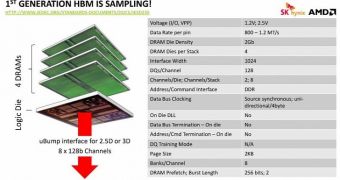A new graphics card is being prepared by Advanced Micro Devices, one that may or may not outclass NVIDIA's GeForce GTX 780 Ti, and which may or may not be called Radeon R9 295X.
Given the name of the current-generation dual-GPU AMD board (Radeon Ro 295 X2), the R9 295X moniker is quite likely.
However, it is just speculation running rampant, and the report that said that a new video card was coming in the summer isn't much more than that either.
Then again, most rumors have a hint of truth in them, and AMD does kind of need something that can match NVIDIA's GeForce GTX 780 Ti, if not the GTX Titan Black.
As some may have surmised by this point, a mere increase in the frequency of the graphics processing unit of the Radeon R9 290X won't cut it.
Fortunately, AMD does have something interesting to introduce: the high-bandwidth memory technology.
In a nutshell, it's the idea of stacked memory applied to VRAM chips. AMD will take a bunch of DRAM dies and stack them one on top of the other in a single package.
This will not only increase capacity and performance, but should reduce power draw and temperature, not to mention the size of the PCB (printed circuit board).
Much of the space on a PCB is there because those many VRAM chips need the room to stretch. HBM, though, will do away with that issue.
Advanced Micro Devices will start out with 8 Gigabit 4Hi chips, according to VideoCardz, and 128-bit paths for them.
Since the company is bound to stick to the 512-bit memory interface of the Hawaii silicon, it will allow the supposed Radeon R9 295X to function fully with just four memory packages on the board.
All this won't increase VGA performance by a tremendous amount, since memory bandwidth doesn't have that large an impact. However, between HBM and better clocks for the Hawaii GPU, the Radeon R9 295X (or whatever it's called) should put on a good show.
As for the price, we can only try to guess. The Radeon R9 290X sells for as “little” as $450 / €450, and the R9 295X will do something between replace and complement it, so a tag of $500 / €500 - $600 / €600 isn't out of the question. Maybe even $700 / €700 is on the table, since it would still be less than half of the $1,500 / €1,500 demanded by the R9 295 X2 dual-chip model.

 14 DAY TRIAL //
14 DAY TRIAL //